Filleting Fish
The term Filleting Fish describes a method of removing the meat from both sides of a fish while separating the fish fillets from the bones and entrails which then can be easily disposed. When done successfully this yields two pieces of fillets ready for cooking or the freezer that are virtually free from fish bones. With some species of fish - like trout - you cook them with the skin intact, and/or remove scales first. For many species, such as bass, crappie, walleye and northern pike, this filleting process is preferred.
Learning to clean fish with the fillet process is a simple 4 step process. The pictures below outlines these four steps on a nice walleye. Click this link to read more about the tools for cleaning fish: Tools To Clean A Fish.
- Insertion of knife behind the gill plate and down to but not through the back bone
- Turn knife towards tail and cut parallel to the backbone, towards the tail but not all the way through the skin at the tail
- Flip the skin/meat flap over and cut/separate the meat from the skin keeping the knife skimming between the meat and the skin.
- Finally, Cut the rib bones from the fillet; Then repeat these steps on the opposite side.
Filleting Fish Technique
These 4 steps are demonstrated in the following 10 pictures:
Step One:
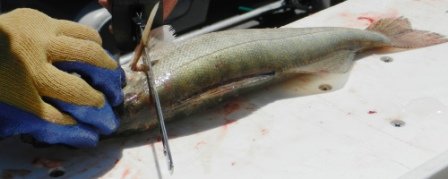
Behind gill and down to the backbone but not through it.
Step Two:
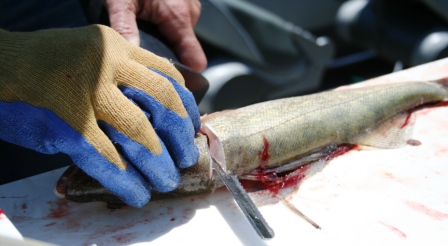
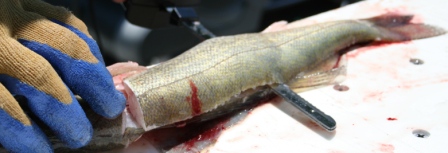
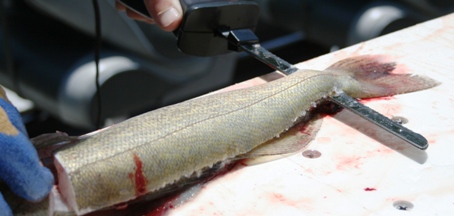
Run knife along backbone toward tail but not through the tail. Slow and steady, do not cut through the back bone, stay just above it. Stop just before you cut through the skin as you approach the tail, so that you can flip the fillet with skin still attached over to begin removing the fillet from the skin. Let the knife do the work, don't force it. With practice you will gain speed and confidence.
Step Three

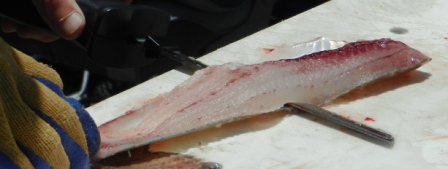

This removes the flesh from the skin. Keep a downward pressure on your knife while you push the blade away from the fish body. As you can see you will be left with a nice fillet with only the rib bones. Flip the skin back over the body, turn the fish over and repeat on opposite side. You now have two fillets - ready for rinsing and removal of ribs. Some will remove rib bones as they go, while others will fillet all fish caught and then proceed to remove rib bones all at the same time.
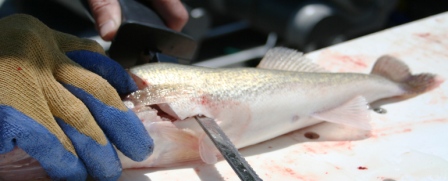
At this point you are ready to dispose of the fish body and entrails.
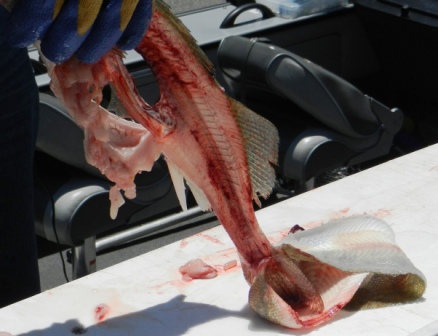
Step Four:
Removing the rib bones is very easy. After removal place the cleaned fillet into the final rinse. Some anglers prefer a fixed blade hand held fillet knife, while others find the electric fillet knife is easier for both the fillet process and removal of ribs
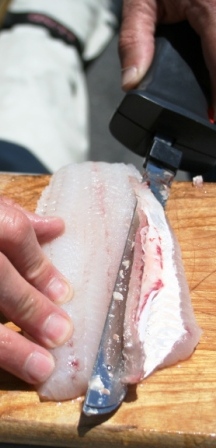
In Summary
There may be other methods to clean your fish - perhaps as many methods as there are anglers who clean fish. The filleting fish method is used by many who find it easy, and results in two nice fillets without bones. With practice you will find that you can serve your fillets with the confidence that you have removed virtually all the bones in the fish. When you eat fish, however, always remember fish have bones, lots of bones, and no matter how careful anyone is when cleaning or filleting fish, a bone can accidentally be missed and wind up in a cooked piece of fish.
Become An Expert
Now that you have become familiar with the steps in actually filleting your fish, click on the links below to review the tools and supplies you might need to fillet your fish, and to read about other techniques to make the perfect fillet.
- HOW TO FILLET FISH: Learn about fish anatomy - Find Your Fillet, Clean Rinsing, Freezing Fish Fillets
- ALL ABOUT FILLET KNIVES, Electric Fillet Knives
- HOW TO CLEAN FISH: Pick up all the tools you need to learn how to fillet fish
- FILLET BOARD OVERVIEW: Wood, HDPE, Plastic, Size - Not sure read here.
- AVAILABLE FILLET BOARDS: Read about the different styles and their advantages here.